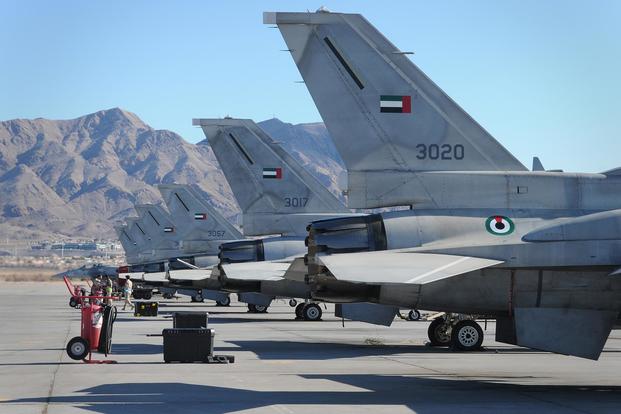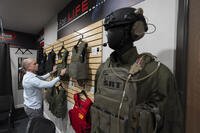Editor's Note: Air Forces Central Command has released new information related to these exercises that contradicts what officials previously told Military.com. AFCENT on Aug. 1, 2019, said the Air Warfare Center did support this exercise, and coordinated U.S. participation, according to spokeswoman Capt. Amanda Farr. Two F-16 fighters, one B-1 bomber, one KC-10 tanker, one E-3 Airborne early warning and control aircraft, and a "white cell" support staff participated, Farr said in an email. "U.S. personnel assigned to the AWC also assisted coalition partners in improving tactical capability and interoperability, [and] assisted in developing tactics, techniques and procedures," she said.
The U.S. military was not planning to participate in a recent United Arab Emirates-led exercise with Middle East partners even before a decision was made to curtail American operations related to Yemen, Military.com has learned.
The U.S. Air Force did not partake in the Advanced Tactical Leadership Course, coordinated by the Air Warfare Center at Al Dhafra Air Base, UAE, this past October, according to Central Command spokesman Army Lt. Col. Josh Jacques.
The course, which focuses on flight leadership, training and flight safety, "varies from year to year," Jacques said.
"It was held in the UAE as they always host it, however, the United States did not participate in 2018," Jacques said in an email.
Related content:
- Saudi Coalition Down '1 to 2' Tankers of Fuel Daily After US Ends Refueling Mission
- Air Force Refueling Mission Over Horn of Africa Holds Steady
- Leadership Course Preps Middle East Allies for Real-World Battles
Jacques could not confirm whether the U.S. would drop out of the upcoming 2019 exercise with its Middle East partners, but said it was "possible."
Asked why the U.S. did not participate in October, Jacques said it is not uncommon for the U.S. military to withdraw from annual exercises, but could not cite a specific reason.
The last time the Defense Department publicly participated in the exercise was in 2016, according to military releases and photographs. There have been at least 25 ATLCs since the course's inception in 2004.
The region's seven-week version of the Air Force's "Red Flag" exercise starts out with participants hitting the books and mission plans, then training regional partners for the role of mission commanders.
The latest news about the ATLC follows a report from Yahoo News that said the U.S. had trained UAE and Saudi Arabia in "combat operations" sometime between Jan. 2016 and Dec. 2017, even as the Defense Department consistently denied that training was happening.
Documents, obtained by a Freedom of Information Request, showed that the U.S. "escorted six UAE F-16s to RED FLAG" and "assisted 150 airmen in challenging ex[ercise] to prepare for combat ops in Yemen," according to Yahoo's report.
It wasn't immediately clear if the Red Flag exercise mentioned in the 2017 FOIA document was the notorious U.S. Air Force-led exercise held multiple times throughout the year at Nellis Air Force Base, Nevada, or UAE's version of the exercise.
The U.S.-based Red Flag exercise, established in 1975 at the end of the Vietnam War, is an integrated, multi-force training exercise within a simulated combat environment.
It’s no secret that UAE, as well as Saudi Arabia, have participated in the U.S.'s Red Flag many times before.
"Our big mission here is to host big exercises for the region," to include interoperability, tactical capability, and air operations, which includes missile defense with Middle Eastern partners, the Gulf Cooperation Council and other coalition warfighters "that we're fighting currently with" side-by-side, said Air Force Col. Steven Boatright, then-commander of the Air Warfare Center, in 2016.
Military.com spoke to Boatright then about the Advanced Tactical Leadership Course as the Saudi-led operation to strike Houthi rebels in Yemen approached the two-year mark.
At the time, the Air Force had viewed the strategic exercise as a way for the coalition to mitigate civilian casualties, the colonel said.
"Saudi Arabia and United Arab Emirates are fighting in Yemen, and the missions we talk about here [are] directly transferrable -- the issues of civilian casualties," Boatright said at the time. "The key takeaway is, [the partners] are doing the fighting ... and they've gotten to this point, they're very capable air forces, and these exercises just make them better."
"From an American serviceman's perspective, we're busy enough as it is in Iraq and Syria, and the fact that they're handling that situation is a good thing," Boatright added, alluding to consistent U.S.-led strikes during Operation Inherent Resolve.
That year, the U.S. averaged 2,550 strikes against the Islamic State in Iraq and Syria per month, according to Air Forces Central Command.
Besides the Advanced Tactical Leadership Course, Jacques said Gulf Cooperation Council partners and allies often cooperate with the U.S. military at the Air Warfare Center for various kinds of training.
That still includes reducing civilian casualties.
"For over 15 years, the Air Warfare Center has served as a unique location for DoD's multilateral air and missile defense training efforts in the Middle East. Its programs support the acquisition of greater capabilities and interoperability between the United States, European nations and our GCC partners," Jacques said. "This is a long-term training effort that is distinct from any day-to-day military operations."
He continued, "The Department of Defense has taken measures to assist the Saudi-led coalition, which includes the Emirates, in mitigating civilian casualties through military-to-military key leadership engagements, seminars and advisory teams that provide recommendations to improve operational effectiveness and reduce the risk of civilian casualties."
The Trump administration has received congressional pushback for its support of Saudi Arabia in arms sales and intelligence after the death of journalist Jamal Khashoggi, a Washington Post columnist.
Khashoggi is believed to have been killed by Saudi operatives at the Saudi Consulate in Istanbul in October.
Lawmakers for the last three years have tried a variety of ways to oppose the war.
In December, the Senate voted 56 to 41 to end additional U.S. military assistance for Saudi Arabia's coalition.
-- Oriana Pawlyk can be reached at oriana.pawlyk@military.com. Follow her on Twitter at @oriana0214.










